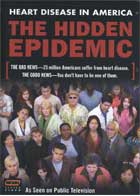
Heart Disease in America. The Hidden Epidemic 2007
Distributed by WGBH Boston, 125 Western Avenue, Boston, MA 02134; 617-300-2000
Produced by Elizabeth Arledge
Directed by Elizabeth Arledge
DVD, color, 116 min.
Sr. High - Adult
Health Sciences
Date Entered: 05/04/2007
Reviewed by Lori Widzinski, Health Sciences Library, University at Buffalo, State University of New YorkThe statistics on heart disease in the U.S. today are quite alarming. It is the number one killer—especially among women where it outnumbers deaths from all types of cancer combined. If we don’t die because of it, 80% of us will die with it. Every 26 seconds there is a cardiac event in this country. Why? How did this disease reach these epic proportions in our country?
Produced for public television, WGBH has created Heart Disease in America. The Hidden Epidemic, an exceptional program on the current state of heart disease in the U.S. To understand why we are experiencing high rates of this deadly disease, and how to prevent it, producer and director Elizabeth Arledge explains the staggering statistics by telling the story of the research done on cardiovascular disease. As stated in the film, to figure out how to overcome and prevent something, you have to know how it starts. Using the encompassing and groundbreaking Framingham Heart Study as a framework for the film, Arledge highlights the “early days” of cardiovascular research, making it compelling viewing with first hand accounts of the painstaking methods of data collection and adding a touch of humor with television ads from the 50s promoting the change in a “manual” lifestyle to a more automated one. The concept of the Framingham Study itself is quite interesting. The children of the original volunteers are now participating in the continuation of the Study.
In the last 60 years, doctors’ entire way of thinking about heart disease has changed. Out of the Framingham Study came the concept of “risk factors” and we now know abut the effects of high blood pressure, smoking, nutrition and exercise. The good news is that cardiovascular disease is largely preventable; the bad news is that most people don’t follow simple steps to fend it off until a catastrophic cardiac event happens to them or someone close to them.
This program has it all—the history of heart disease and the Framingham study; the statistics; knowledgeable experts explaining the science in easily digestible segments; great looking animation and graphics to illustrate their points; heart-tugging stories from people who are either suffering from or lost loved ones to common heart disease as well as extreme genetic cases; and prevention techniques—all wrapped up in the professional PBS documentary package topped with the WGBH bow. Who could ask for anything more? There is more—an additional 30 minute program on the DVD called Take One Step, in which a panel of medical experts answers questions posed by moderator Larry King. It’s a valuable addition, covering common questions on heart disease and dispelling some of the myths. Other DVD extras include fact sheets, heart healthy recipes, easy steps to a healthy heart and a link to the PBS web site.
Made for a general adult audience, this film will work well in health sciences classrooms, particularly undergraduate nursing, pre-med, and allied health programs. The almost 2 hour length is problematic for classroom viewing, but it is divided into chapters that instructors will find useful. Like other PBS videos, Heart Disease in America is very affordable and will make a good addition to public libraries as well as academic collections. If you haven’t seen this film, watch it. If you have, tell someone about it. You can preview the program online at PBS on the program’s web site.